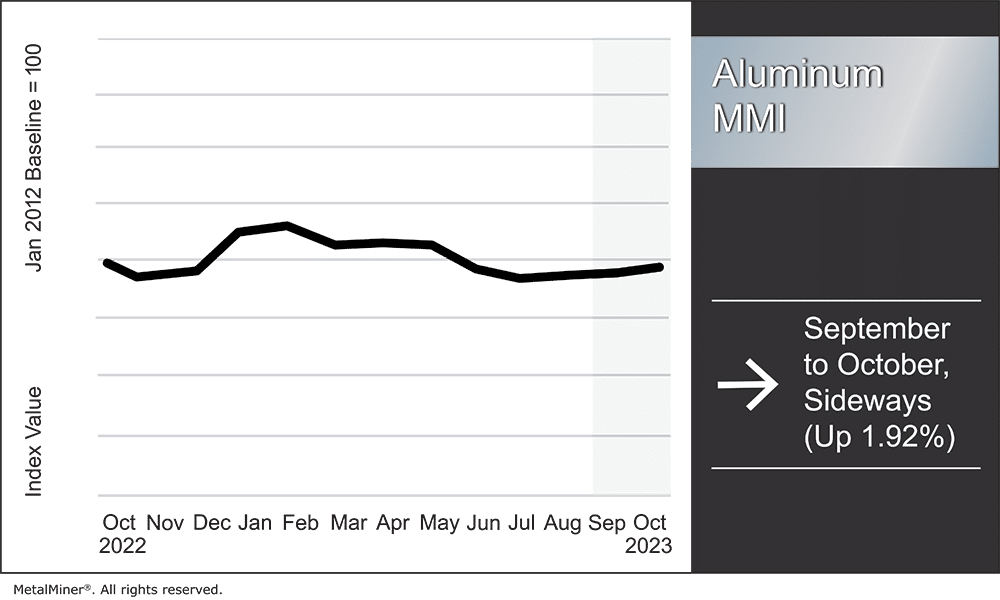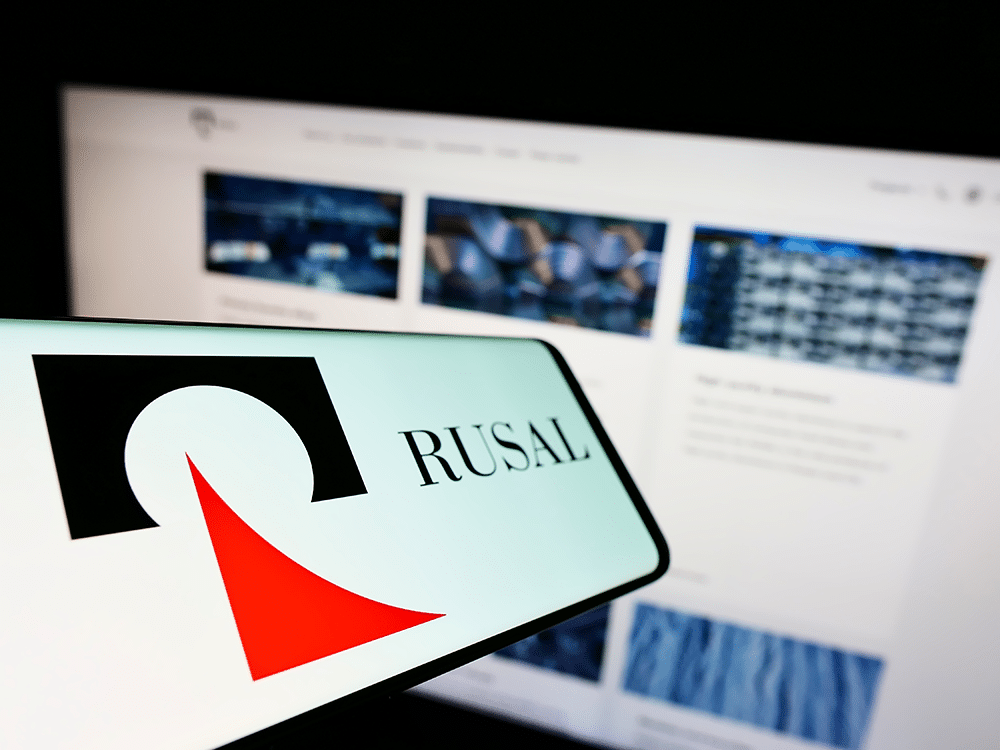Overall, the Aluminum Monthly Metals Index (MMI) moved sideways, with a modest 1.92% rise from September to October. Indeed, a short-lived spike at the end of September saw aluminum prices rise over 6% month over month. However, prices began to retrace throughout October. They not only lost all of last month’s gains but returned to their August lows by mid-month. Despite the declines, aluminum prices remain sideways, having yet to break below their long-term range.
Gain access to expert-driven market insight, ensuring your company is well-informed and prepared to tackle falling demand. Opt into MetalMiner’s free weekly newsletter.

Russian Aluminum Moderates to 76% of LME Warehouses
Meanwhile, Indian stocks, which have strongly counterbalanced Russian-origin material, remained low relative to the first half of the year. Nonetheless, a larger draw down of Russian stocks helped even out the overall balance during the month.
The latest data likely comes as a relief to the LME, which continues to fend off concerns that the large presence of Russian-origin metal could distort aluminum prices. However, thus far, LME prices and CME prices continue to show a strong correlation, and the delta between the two remains narrow.
Squarepoint Latest Fund Willing to Buy Russian Aluminum
Amid tariffs and self-sanctioning, Russian aluminum remains at a discount to global prices, which continues to incentivize buyers. Recently, Squarepoint Capital proved to be the latest hedge fund willing to buy the shunned material. This follows other major companies like Citigroup, which also made significant purchases in recent months.
According to a recent Bloomberg report, Squarepoint requested delivery of roughly 50,000 tons of Russian-origin aluminum from LME warehouses in South Korea. The overall purchase totaled more than $100 million, with most of the material stemming from Rusal. Since the country’s invasion of Ukraine, governments have fallen short of banning the trade of Russian aluminum outright. This continues to allow funds like Squarepoint and Citigroup to buy and sell large volumes of the material.

Purchases by such funds, along with buys from other countries, continue to help moderate the impact of the large presence of discounted Russian-origin material within LME warehouses. China, in particular, ramped up aluminum imports from Russia amid the burgeoning alliance between the two nations. However, despite their record-high production levels, it remains unclear how long China is willing to sustain these purchases. Moreover, any significant drop-off in aluminum imports to China could increase Russian deliveries to the LME, again upsetting the balance within its warehouses.
Elevate your procurement IQ. The Monthly Metals Outlook report is your booster for strategic aluminum sourcing. Get a sneak peek with a sample report.
U.S. and EU Negotiate Tariff Agreement
Although they remain largely intact, in recent years, the Biden Administration has continued to work with other countries to negotiate exemptions following the 2018 implementation of Section 232 tariffs on steel and aluminum. For Europe, the exemptions translated to a quota allowing volumes below historical steel and aluminum levels into the U.S. free of duties. In a bid to avoid their full return, EU officials will meet with President Biden during a one-day summit on Sep. 20 to discuss a broad range of topics related to the global economy.
According to reports, the U.S. continues to pressure the EU to act against Chinese overcapacity. In fact, the U.S. specifically wants the EU to impose a duty on Chinese-origin steel. However, while the U.S. favors using tariffs, the EU follows WTO rules. These require an anti-dumping investigation by the trade body before they can administer any such duties. Still, the EU currently hopes to appease the U.S. by initiating such an investigation into unfair subsidies from non-market economies like China.
It remains unclear what outcome the U.S. and EU will negotiate. Trade discussions will also cover Europe’s carbon border tariff system and U.S. subsidies related to the IRA, which come with sourcing and assembly requirements.
An initial jump in both U.S. HRC prices and Midwest aluminum premium futures followed the start of Section 232 tariffs in March 2018. This could occur again should the U.S. and EU fail to reach an agreement. However, both steel and aluminum prices currently appear much more driven by their larger trends than by any shift in import tariffs.
Following the pandemic and amid the sharp price run-up, the EU and U.S. reached their initial tariff rate quota (TRQ) agreement in October 2021. This went into effect at the beginning of 2022. U.S. steel prices started to retrace from their all-time highs at that point, although the Midwest aluminum premium peaked soon after.
Get a visual representation of where 2024 aluminum costs are projected to land with MetalMiner Insights’ comprehensive short and long-term price forecasts. Chat with us.
Biggest Moves for Aluminum Prices
- LME primary three month aluminum prices saw the largest increase of the index, jumping 3.92% to $2,265 per metric ton as of October 1.
- Chinese aluminum billet prices rose 3.8% to $2,805 per metric ton.
- Meanwhile, the Korean 5052 coil premium over 1050 fell 5.72% to $3.80 per kilogram.
- The Korean 3003 coil premium over 1050 declined 5.86% to $3.69 per kilogram.
- Korean commercial 1050 sheet prices fell 5.91% to $3.65 per kilogram.




